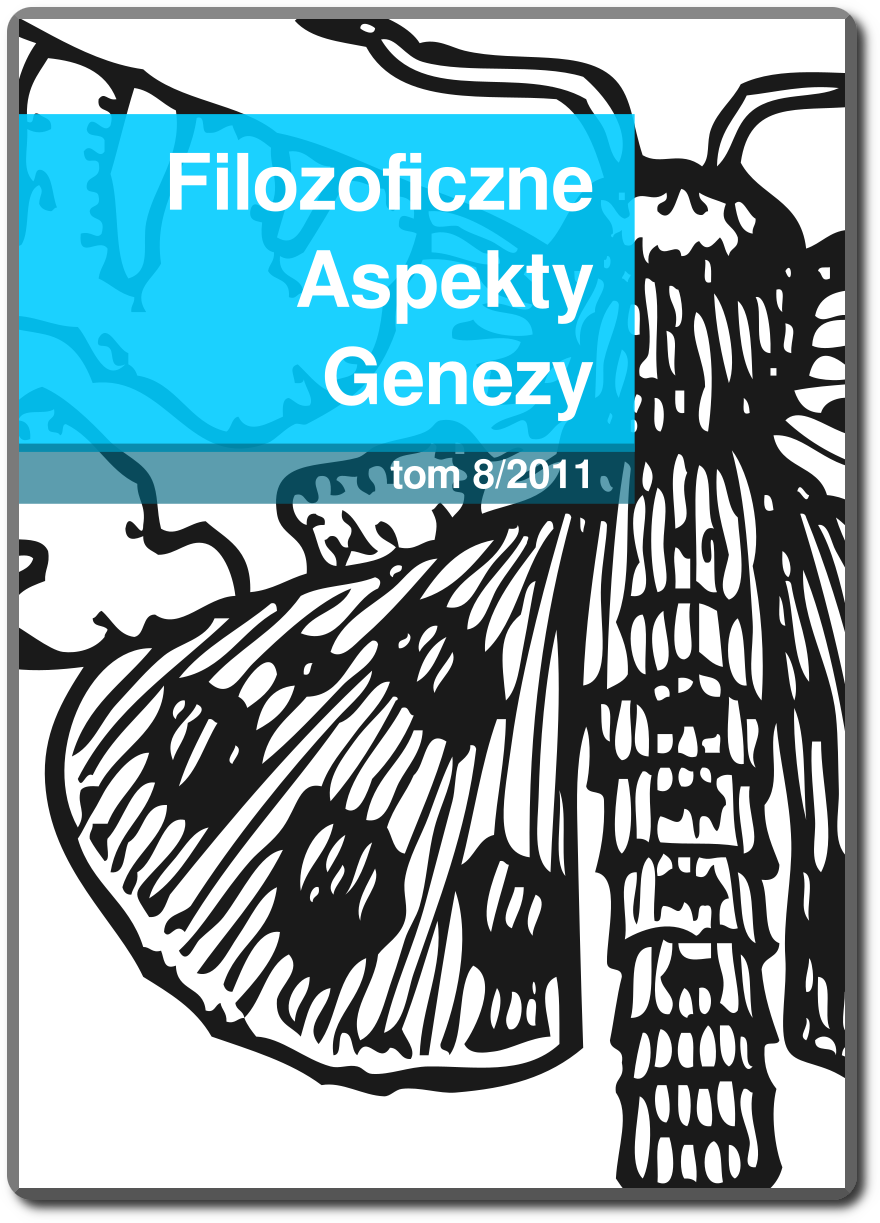Opublikowane 21.05.2021
Słowa kluczowe
- geny,
- przyczynowość genetyczna,
- program genetyczny,
- kodowanie cyfrowe,
- reprezentacja analogowa
- dziedziczność komórkowa ...More

Utwór dostępny jest na licencji Creative Commons Uznanie autorstwa 4.0 Międzynarodowe.
Jak cytować
Abstrakt
Ukazanie powiązań między genotypem a fenotypem jest problematyczne nie tylko ze względu na ogromną złożoność interakcji między genami, białkami i funkcjami fizjologicznymi wyższych rzędów, ale również dlatego, że paradygmatom przyczynowości genetycznej w systemach biologicznych towarzyszy duże zamieszanie. W tym artykule przeanalizuję niektóre związane z tym błędne przekonania, zaczynając od zagadnienia definicji genu. W toku rozwoju biologii uległa ona zasadniczej zmianie - pierwotnie gen rozumiano jako przyczynę cech fenotypowych, obecnie definiuje się go jako fragment DNA. Następnie przejdę do następujących zagadnień: czy "cyfrowa" natura sekwencji DNA gwarantuje im pierwszeństwo w ciągu przyczynowym w porównaniu z dziedzicznością niezwiązaną z DNA, czy koncepcja programów genetycznych jest sensowna i użyteczna oraz jaka jest rola przyczynowości na wyższych poziomach (przyczynowości odgórnej). Metafory, które dobrze spełniały swoją funkcję podczas molekularnej fazy rozwoju biologii w ostatnich dziesięcioleciach, mają ograniczone zastosowanie w wielopoziomowym świecie biologii systemowej, a nawet mogą pro-wadzić do nieporozumień. Wyjaśnienie wieloczynnikowej przyczynowości genetycznej związanej z funkcjami fizjologicznymi wyższych rzędów wymaga nowych paradygmatów, które zarazem pozwolą zrozumieć zjawiska badane pierwotnie przez genetykę. Modelowanie funkcji biologicznych umożliwia rozwiązanie "problemu genetycznego efektu różnicowego" i odegra istotną rolę również w wyjaśnieniu przyczynowości genetycznej.
Downloads
Bibliografia
- Johannsen W., Elemente der exakten Erblichkeitslehre, Gustav Fischer, Jena, Germany 1909.
- Mayr E., The Growth of Biological Thought, Harvard University Press, Cambridge, Massachusetts 1982.
- Kitcher P., „Genes”, British Journal for the Philosophy of Science 1982, vol. 33, s. 337-359 (doi:10.1093/bjps/33.4.337).
- Dupré J., The Disorder of Things, Harvard University Press, Cambridge, Massachusetts 1993.
- Pichot A., Histoire de la notion de gène, Flammarion, Paris, France 1999.
- Keller E.F., The Century of the Gene, Harvard University Press, Cambridge, Massachusetts 2000.
- Keller E.F., „Is There an Organism in this Text?”, w: P.R. Sloan (ed.), Controlling Our Destinies: Historical, Philosophical, Ethical and Theological Perspectives on the Human Genome Project, University of Notre Dame Press, Notre Dame, Indiana 2000, s. 273-288.
- Pearson H., „Genetics: What Is a Gene?”, Nature 2006, vol. 441, s. 398-401 (doi: 10.1038/441398a).
- Schrödinger E., Czym jest życie? Fizyczne aspekty żywej komórki, przeł. Stefan Amsterdamski, Klasycy Nauki, Prószyński i S-ka, Warszawa 1998.
- Bickel K.S. and Morris D.R., „Silencing the Transcriptome’s Dark Matter: Mechanisms for Suppressing Translation of Intergenic Transcripts”, Molecular Cell 2006, vol. 22, s. 309-316 (doi:10.1016/j.molcel.2006.04.010).
- Qiu J., „Epigenetics: Unfinished Symphony”, Nature 2006, vol. 441, s. 143-145 (doi:10.1038/441143a).
- A. Bird, „Perceptions of Epigenetics”, Nature 2007, vol. 447, s. 396-398 (doi:10.1038/nature05913).
- Scherrer K. and Jost J., „Gene and Genon Concept: Coding versus Regulation”, Theory in Biosciences 2007, vol. 126, s. 65-113 (doi:10.1007/s12064-007-0012-x).
- Noble D., „Claude Bernard, the First Systems Biologist, and the Future of Physiology”, Experimental Physiology 2008, vol. 93, s. 16-26 (doi:10.1113/expphysiol.2007.038695).
- Noble D., „Commentary on Scherrer and Jost (2007) Gene and Genon Concept: Coding versus Regulation”, Theory in Biosciences 2009, vol. 128, s. 153-154 (doi:10.1007/s12064-009-0073-0).
- Gluckman P. and Hanson M., The Fetal Matrix: Evolution, Development and Disease, Cambridge University Press, Cambridge, UK. 2004.
- Jablonka E. and Lamb M., Epigenetic Inheritance and Evolution: The Lamarckian Dimension, Oxford University Press, Oxford, UK. 1995.
- Jablonka E. and Lamb M., Evolution In Four Dimensions, MIT Press, Boston, Massachusetts 2005.
- Roux A., Cuvelier D., Bassereau P., and Goud B., „Intracellular Transport: From Physics to Biology”, Annals of the New York Academy of Sciences 2008, vol. 1123, s. 119-125 (doi:10.1196/annals.1420.014).
- Werner E., „How Central Is the Genome?”, Science 2007, vol. 317, s. 753-754 (doi:10.1126/science.1141807).
- Dawkins R., Samolubny gen, przeł. Marek Skoneczny, Na Ścieżkach Nauki, Prószyński i S-ka, Warszawa 1996.
- Noble D., The Music of Life, Oxford University Press, Oxford, UK. 2006.
- Smith J. Maynard i Szathmáry E., Tajemnice przełomów w ewolucji. Od narodzin do powstania mowy ludzkiej, przeł. Michał Madaliński, Wydawnictwo Naukowe PWN, Warszawa 2000.
- Smith J. Maynard, Evolutionary Genetics, Oxford University Press, New York 1998.
- Smith J. Maynard and Szathmáry E., The Origins of Life, Oxford University Press, New York 1999.
- Neuman Y., „The Rest Is Silence”, Perspectives in Biology and Medicine 2007, vol. 50, s. 625-628 (doi:10.1353/pbm.2007.0053).
- Dawkins R., Fenotyp rozszerzony. Dalekosiężny gen, przeł. Joanna Gliwicz, Prószyński i S-ka, Warszawa 2003.
- Jones S., The Language of the Genes, HarperCollins, London, UK. 1993.
- Tian X.C., Kubota C., Enright B., and Yang X., „Cloning Animals by Somatic Cell Nuclear Transfer — Biological Factors”, Reproductive Biology and Endocrinology 2003, vol. 1, s. 98-105 (doi:10.1186/1477-7827-1-98).
- Monod J. and Jacob F., „Teleonomic Mechanisms in Cellular Metabolism, Growth and Differentiation”, Cold Spring Harbor Symposia on Quantitative Biology 1961, vol. 26, s. 389-401.
- Hardin P.E., Hall J.C., and Rosbash M., „Feedback of the Drosophila Period Gene Product on Circadian Cycling of Its Messenger RNA Levels”, Nature 1990, vol. 343, s. 536-540 (doi:10.1038/343536a0).
- Foster R. and Kreitzman L., Rhythms of Life, Profile Books, London, UK. 2004.
- Debruyne J.P., Noton E., Lambert C.M., Maywood E.S., Weaver D.R., and Reppert S.M., „A Clock Shock: Mouse Clock Is Not Required for Circadian Oscillator Function”, Neuron 2006, vol. 50, s. 465-477 (doi:10.1016/j.neuron.2006.03.041).
- Atlan H. and Koppel M., „The Cellular Computer DNA: Program or Data”, Bulletin of Mathematical Biology 1990, vol. 52, s. 335-348 (doi:10.1007/BF02458575).
- Coen E., The Art of Genes, Oxford University Press, Oxford, UK. 1999.
- Jacob F., The Possible and the Actual, Pantheon Books, New York 1982.
- Brenner S., „Biological Computation”, w: G.R. BOCK and J.A. GOODE (eds.), The Limits of Reductionism in Biology, Novartis Foundation Symposium, no. 213, Wiley, London, UK. 1998, s. 106-116.
- Strohman R., „Organisation Becomes Cause in the Matter”, Nature Biotechnology 2000, vol. 18, s. 575-576 (doi:10.1038/76317).
- Neuman Y., „Cryptobiosis: A New Theoretical Perspective”, Progress in Biophysics and Molecular Biology 2006, vol. 92, s. 258-267 (doi:10.1016/j.pbiomolbio.2005.11.001).
- Hodgkin A.L. and Huxley A.F., „A Quantitative Description of Membrane Current and Its Application to Conduction and Excitation in Nerve”, Journal of Physiology 1952, vol. 117, s. 500-544.
- Tautz D., „Redundancies, Development and the Flow of Information”, BioEssays 1992, vol. 14, s. 263-266 (doi:10.1002/bies.950140410).
- Werner E., „Genome Semantics. In silico Multicellular Systems and the Central Dogma”, FEBS Letters 2005, vol. 579, s. 1779-1782 (doi:10.1016/j.febslet.2005.02.011).



